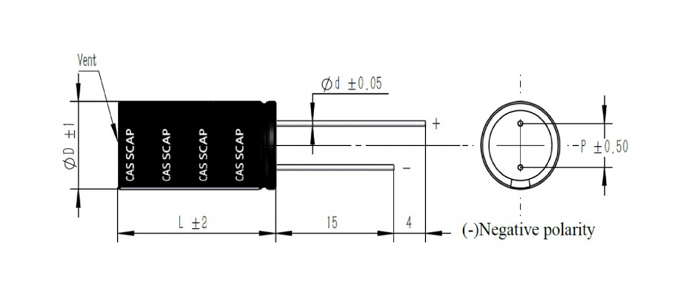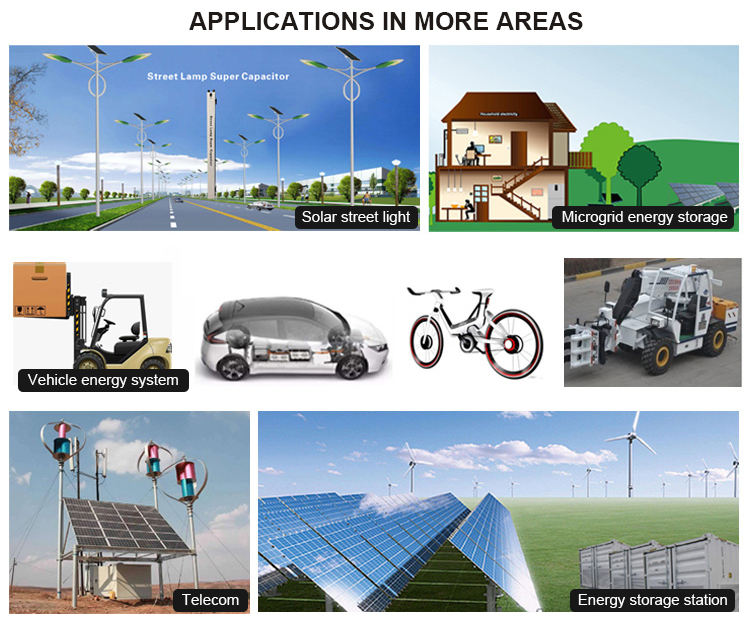Consulting phone:
135-3037-2041
(Mr.Wang)
Product introduction:
Cylindrical supercapacitor, also known as electrochemical capacitor or electric double layer capacitor, is a new type of energy storage device. It uses the electric double layer on the electrode/electrolyte interface or the rapid and reversible redox reaction on the electrode interface to store energy.
The cylindrical supercapacitor is made of activated carbon materials to form porous carbon electrodes. At the same time, the electrolyte solution is filled between the opposite porous electrodes. When the voltage is applied at both ends, the opposite porous electrodes have positive and negative electrons, while the positive and negative ions in the electrolyte solution will be respectively on the interface opposite to the positive and negative electrode plates due to the electric field, thus forming two collector layers.
Series specification table:
Specification | characteristic | |||||||
Rated voltage V R | 3.2V | |||||||
surge voltage | 3.35V | |||||||
Capacity range | 7F | |||||||
Operating temperature range | -40℃~+65℃ | |||||||
Product life | Normal temperature cycle life: at 25 ℃, with a constant current capacitor 1,000,000
cycles of charge and discharge between the specified voltage and half
rated voltage. Capacity attenuation ≤30% times, internal resistance
change ≤3 times | |||||||
High temperature endurance life: under the condition of +65℃, the rated voltage is applied for 1000 hours. Capacity attenuation 30%, internal resistance change ≤3 times | ||||||||
Product performance table:

Application areas:

testing method:
1. Electrostatic capacity test method:
(1) Test principle
Super capacitor The electrostatic capacity of the capacitor is tested by the method of constant current discharge of the capacitor, and it is calculated according to the formula.
C=It(U1-U2)
In the formula: C - electrostatic capacity, F;
I-constant discharge current, A;
U1, U2 - use voltage, V;
t-Discharge time required for U1 to U2, S
(2), test procedure
Charge the capacitor with a current of 100A, charge the capacitor to the working voltage and keep the voltage constant for 10 seconds, then discharge the capacitor with a current of 100A, take U1 as 1.2V and U2 as 1.0V, record the discharge time within this voltage range, and the total cycle Capacitance, take the average value.
2. Stored energy test
(1) Test principle:
The test of supercapacitor energy is carried out by the method of discharging the capacitor with constant power to 1/2 of the working voltage with the given voltage range of the capacitor. The output energy W of the capacitor is obtained from the relationship between the constant discharge power P and the discharge time T, namely:
W=P.T
(2) Test procedure
Charge the capacitor to the working voltage with a constant current of 100A, and then keep it constant until the charging current drops to the specified current (10A for traction type, 1A for start-up type), after 5 seconds of rest, discharge the capacitor with constant power to 1/2 of the working voltage, record Discharge time and calculate magnitude. Repeat the measurement 3 times and take the average value.
3. Equivalent series resistance test (DC)
(1) Test principle
The internal resistance of the capacitor is measured according to the sudden change of the voltage within 10 milliseconds of the capacitor disconnecting the constant current charging circuit. That is: in the formula:
R - the internal resistance of the capacitor;
U0 - capacitor cut off the voltage before charging;
Ui - cut off the voltage within 10ms after charging;
I - cut off the current before charging.
(2) Measurement process
Charge the capacitor with a constant current of 100A, disconnect the charging circuit when the charging working voltage is 80%, use a sampling machine, record the voltage change value within 10 milliseconds after the capacitor is powered off, and calculate the internal resistance, repeat 3 times, and take the average value.
4. Leakage current test
After charging the capacitor to the rated voltage with a constant current of 100A, charge the capacitor with a constant voltage for 30min at this voltage value, and then leave it open for 72h. During the first three hours, the voltage value was recorded every minute, and during the remaining time, the voltage value was recorded every ten minutes.
Calculate the self-discharge energy loss, SDLF=1-(V/VW)2, and the calculation time points are: 0.5, 1, 8, 24, 36, 72h.
Note: The voltage tester must have high input impedance to minimize the impact of discharge.